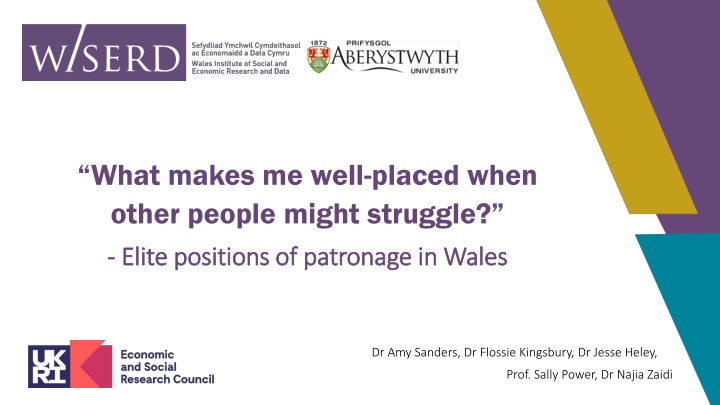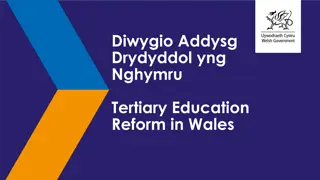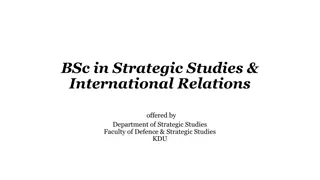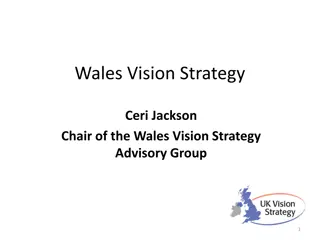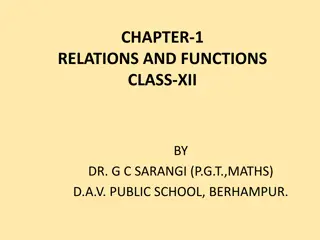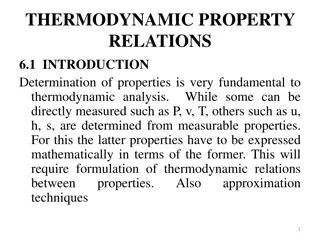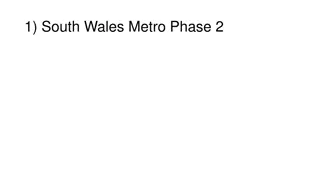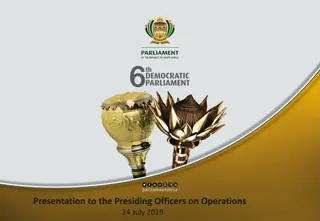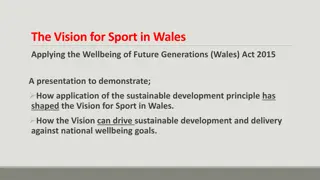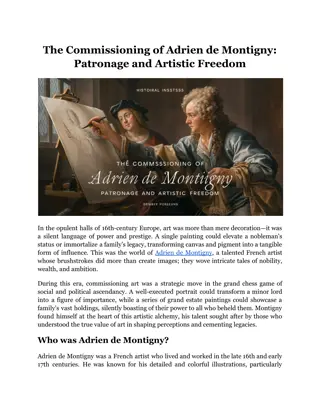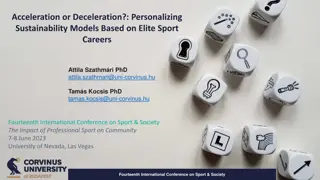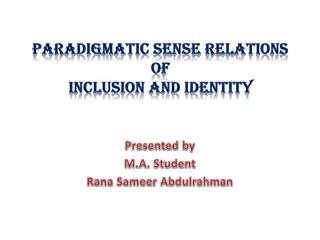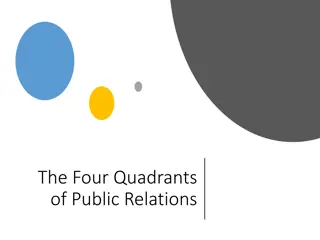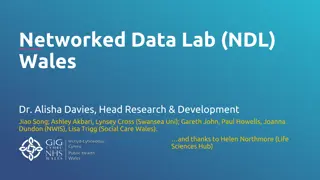Elite Patronage and Power Relations in Wales: Research Insights
Research project on elite positions of patronage in Wales, focusing on systems of patronage within civil society, access to elite roles in charities, and the reproduction of capital in civil society. Theoretical framework includes discussions on gender, education, and exclusionary practices in civil society, exploring how individuals like Dr. Amy Sanders, Dr. Flossie Kingsbury, Dr. Jesse Heley, Prof. Sally Power, and Dr. Najia Zaidi are well-placed in elite positions. Illustrative images and in-depth analysis provided throughout the study.
Uploaded on Sep 18, 2024 | 2 Views
Download Presentation

Please find below an Image/Link to download the presentation.
The content on the website is provided AS IS for your information and personal use only. It may not be sold, licensed, or shared on other websites without obtaining consent from the author.If you encounter any issues during the download, it is possible that the publisher has removed the file from their server.
You are allowed to download the files provided on this website for personal or commercial use, subject to the condition that they are used lawfully. All files are the property of their respective owners.
The content on the website is provided AS IS for your information and personal use only. It may not be sold, licensed, or shared on other websites without obtaining consent from the author.
E N D
Presentation Transcript
What makes me well-placed when other people might struggle? - - Elite positions of patronage in Wales Elite positions of patronage in Wales Dr Amy Sanders, Dr Flossie Kingsbury, Dr Jesse Heley, Prof. Sally Power, Dr Najia Zaidi
Overview Introduction to our Research Project Introduction to our Research Project Theoretical Framework Theoretical Framework Research Questions Research Questions Research Methods Research Methods Emergent Findings Emergent Findings Conclusions Conclusions
Patronage, Elites and Power Relations An ongoing work package in the ESRC WISERD Civic Stratification and Civil Repair Centre Examines the systems of patronage within civil society Examines the systems of patronage within civil society access to elite roles in charities access to elite roles in charities Draws on Lockwood s (1996) Civic Exclusion and Civic Expansion: groups at risk of civic Draws on Lockwood s (1996) Civic Exclusion and Civic Expansion: groups at risk of civic exclusion and the institutional measures utilised to promote civic expansion exclusion and the institutional measures utilised to promote civic expansion Defining patron: Defining patron: patron - variety of meanings, changed over time (Tribe 2020) Our study adopted a broad definition, includes trustees, presidents, and other honorary roles
Theoretical Framework - Elite Reproduction Reproduction of capital in civil society: Reproduction of capital in civil society: A complex interrelationship between different A complex interrelationship between different forms of capital and privileged positions in civil forms of capital and privileged positions in civil society society (Shucksmith 2012) For example, gender and education have been For example, gender and education have been shown to confer access to certain elite positions shown to confer access to certain elite positions (Bond 2012; Reeves et al. 2017) Fraser s subaltern counter Fraser s subaltern counter- -publics : whereby excluded groups (e.g. gender, race and class) find ways to develop their whereby excluded groups (e.g. gender, race and class) find ways to develop their own public spheres, to counter historically exclusionary practices of civil society own public spheres, to counter historically exclusionary practices of civil society publics : (Fraser 1990, p.67)
Equal Opportunities and Institutional Inequality Equal opportunities: Equal opportunities: Level the playing field (Roemer 2002) fair start but selection reflects merit (ability + effort) criticised for individualism (Johns and Jordan 2006) Radical approaches: Radical approaches: recognise inequality and discrimination are structural, and moves from: equal treatment to equal conditions, equality of opportunity to equality of outcome (Johns and Jordan 2006; Sigafoos 2021). Institutional inequality Institutional inequality Feminist theorists recognise how institutions construct & reinforce gender inequality (Mackay and Krook 2011) Institutional racism views racism as pervasive in the cultures and structures of organisations. It was highlighted in the Macpherson Inquiry into Stephen Lawrence s murder in 1999 (Craig 2012:29)
The formal and the informal New institutionalism: New institutionalism: concerns itself with both concerns itself with both informal formal formal structures, it focuses on: structures, it focuses on: values and power relations values and power relations how institutions interact with members behaviour how institutions interact with members behaviour informal conventions and conventions and (Lowndes 2008:156). (Lowndes 2008:156). Discursive institutionalism: Discursive institutionalism: gives primacy to discourses and ideas, it considers: gives primacy to discourses and ideas, it considers: how language and ideas shape institutions how language and ideas shape institutions and vice versa and vice versa (Schmidt 2008) (Schmidt 2008)
Resistance to Equalities Strategies Layering: Layering: is a form of incremental change in an institutional setting is a form of incremental change in an institutional setting involving new rules and processes inserted on top of existing ones. involving new rules and processes inserted on top of existing ones. (Mackay 2011; Celis and Lovenduski 2018; Minto and Mergaert 2018) Resistance: Resistance: Feminist literature led the way in recognising the Feminist literature led the way in recognising the resistance strategies used by the status quo that frustrate equality resistance strategies used by the status quo that frustrate equality interventions interventions (Acker 2006; Mackay 2011; Chappell and Waylen 2013; Celis and Lovenduski 2018) Decoupling: Decoupling: Institutions from formal commitments to equalities Institutions from formal commitments to equalities strategies through informal norms and discourses that undermine strategies through informal norms and discourses that undermine them them (Chaney 2006) Reinforcing: Reinforcing: Informal norms can also complement formal rules so Informal norms can also complement formal rules so that the two can work together in concert that the two can work together in concert(Chappell and Waylen 2013)
Positive Action and Positive Discrimination Positive action: Positive action: permits employers to overcome the effects of past discrimination in a limited way, legal in the UK (Bennett et al 2005; Bagilhole 2009; Solanke 2017) Positive discrimination: Positive discrimination: giving employment opportunities to particular groups - is illegal in the UK with just a few exceptions (Johns and Jordon 2006) Controversial, but effective (e.g. women s political representation) (Bennett et al 2005) Charities can use positive action but must not be seen to positively discriminate in their services (Sigafoos 2021)
Inequality between Equalities Ocular Ocular- -centric: centric: Equality measures provides remedy for inequality they can see Equality measures provides remedy for inequality they can see (Solanke 2010) Hierarchy of (In)equalities: Hierarchy of (In)equalities: Hierarchies may form between equalities categories due political salience Hierarchies may form between equalities categories due political salience (Verloo 2006) Gender and race are typically privileged in the hierarchy in policymaking Gender and race are typically privileged in the hierarchy in policymaking across Europe across Europe (Krizsan et al. 2012) It is worthwhile understanding the different equalities contexts in the devolved It is worthwhile understanding the different equalities contexts in the devolved nations nations (Hankivsky et al. 2019)
Research Question How do formal and informal recruitment practices for elite civil society positions lead to civic exclusion and/or civic expansion?
Case Studies Case studies were purposively selected to draw on: Case studies were purposively selected to draw on: cultural, economic, educational and political capital cultural, economic, educational and political capital (Bourdieu 2018) and counter and counter- -publics of disadvantaged communities in key Welsh charities publics of disadvantaged communities in key Welsh charities(Fraser 1990) The Royal Welsh Agricultural Society Welsh National Opera Community Foundation Wales Wales Council for Voluntary Action Wales Council of the Blind Learned Society of Wales National Library of Wales National Museum of Wales Keep Wales Tidy Llamau Race Council Cymru Race Equality First Welsh Refugee Council Displaced People in Action PAVO
Research Methods Semi Semi- -structured elite interviews with trustees and other senior patrons were undertaken structured elite interviews with trustees and other senior patrons were undertaken The elite in elite interviews may refer to people who: The elite in elite interviews may refer to people who: influence important decisions have an elite form of knowledge work within prestigious organisations have control of resources have seniority of position in authority (Smith 2006:p.645). Elite refers to: Elite refers to: those who occupy senior management and board level positions those who occupy senior management and board level positions(Harvey 2011) Discourse analysis was used to interpret the interview data Discourse analysis was used to interpret the interview data (Wodak 2001) through a lens of discursive institutionalism through a lens of discursive institutionalism (Schmidt 2008)
Recognising Privilege and Under-Representation I think you've just got to monitor haven't you and you've got to go out and encourage people that would fit the bill of the of those under-represented groups on your board and encourage them to put their name forward. Participant 35 I suppose the most important thing . is that having a diversity of backgrounds, experiences, views, and lived experiences as well is hugely valuable Participant 30 Even though we're articulating that we want change and equality and inclusivity. I think that there are voices that are still not being heard In order to be able to offer your time, you're in a privileged position I have been really struck in the past two years, about this whole thing around privilege and whiteness. I joined the Privilege Cafe And I learned a lot from that experience I had never thought about myself as privileged before oh my god how on earth did I not think myself as privileged? Participant 17
The role of informal networks in achieving the position I already worked in my day job peripherally with one of the directors And I'd spent some time with [the deputy chief executive] I honestly can't remember if I filled out a form or anything, but I did have a conversation - I wouldn't call it an interview - a conversation with the Chief Executive and the Deputy Chief Executive I get the feeling that they kind of spot somebody through whatever connection and they hound them down, because they like them, they think that they'd be good in our organisation. Participant 44 It was really a colleague, who rang me up one day and said, I'd like to nominate you to [this organisation], would you like to be nominated? So I did a bit of research. And then I said yes, okay This is something we have to change, but it was about knowing people. Participant 21
Institutional Adaptations Institutional formal processes to increase inclusion were reflected but these varied quite a lot It's always open competition. An advert is placed on the website, posted in Welsh national newspapers People apply through an application form or.. a letter and a CV. Participant 33 Processes have been put in place in a more formal manner now it's gone through a far more formal headhunting interviewing process. Participant 17 We put information out to our members... We ask for people to put their names forward. People have to be nominated and seconded by a member and they are then voted for. Participant 1 We don t have members that elect our trustees. The board elects. They are voted in by the board. Participant 2
Who is being included? Age Encourage other people to become trustees, especially younger people, because if you look at most boards most of them they tend to be old. Probably white and inevitably largely male. Participant 11 It was extraordinarily gendered stuff in the early 70s I think my passion to make sure that women got a fair go [dates from that] [The organisation] had been set up predominantly by men. There were some very senior, very wonderful women involved, but they were definitely in the minority. Participant 21 Gender So we're talking about diversity and how we might tap diversity Look at the photographs that your organisation takes most of the photographs are white. Participant 30 Race
Positive Action or Positive Discrimination? We, like a lot of organisations, struggle with diversity, so again, we wanted to address that, and we put an open notice on our website, but people don t come forward. And we had to reach out in the end to try and approach people who we thought would first of all help us represent different communities, but also have got good skills that we would need. Participant 2 We have now got three brand new trustees who are young and never been trustees before getting a hold of them has been a bit of a coup. And we only had one woman on the board. We now have six We [decided] we need more balance, more diversity in both gender, age, and ethnicity. One of the recommendations of the EDI review was that we should have equal numbers of gender balance on the Executive... We had one female but the rest of them were boys A position came up I had my arm twisted to do that, to balance up the gender on the Executive Participant 11 Participant 21
Gender, Age and Race on Board Gender and informal mentors So, I'd actually had a bit of a career coaching, not formally, with a sort of a former colleague and we were looking at how can I progress?... And she did say you need to be looking at board representation An opportunity presented itself It's got me [in] those networks that I wouldn't have had, if I had stayed on the outside. Participant 7 Age & formal processes I think the issue about the age - it's not about getting the old people out. It's about trying to make sure you're engaging the young people all the time. I think that and having a succession plan. Participant 35 We had a [young woman] on our board, and she was in her mid-twenties but it was a problem with her work. She works full time. And all our meetings took place in the daytime. So, to accommodate that [the] meeting starts at four o-clock Participant 2
How these Strategies are being Achieved I like to think that my board is diverse 50:50 women and men... We have a [Pakistani] lady on there I've been trying for five, six years to get people from ethnic backgrounds on the board, and failed. They just weren't interested. But [L] is just brilliant She's second generation She understands what it's like. Participant 13 Race equality appears to be aspirational, and/or somewhat tokenistic Race equality appears to be aspirational, and/or somewhat tokenistic the cost of descriptive representation is essentialism descriptive representation is essentialism ( (Mansbridge the cost of Mansbridge 1999) 1999) The equalities measures are certainly ocular The equalities measures are certainly ocular- -centric: centric: Primarily gender, age and race , and occasionally class. Primarily gender, age and race , and occasionally class. The other protected characteristics are not considered (Religion, The other protected characteristics are not considered (Religion, LGBTQ+, Disability) LGBTQ+, Disability) and neither is intersectionality and neither is intersectionality
Resistance to Formal Equalities Strategies I think the first step is that you just have to be very careful when you're recruiting. It's important to meet them - to ask the opinion of other trustees before you might invite them in. That's what we always do. So, the chair might go and meet a prospective trustee, but usually at least another one or two trustees will also meet them and will feed back to the other trustees on whether they think they'd be a good fit. Participant 6 I said "no you might want to just have a tick box." But I said "it's much better to have a nice relaxed conversation... Diversity means get getting the right people with the right skill sets So I would say look at your boards from a trustee point of view to fill the right gaps [but also consider] Are they reasonable people? Participant 13
Conclusions Some recruitment strategies to promote equality seem to cross the line from Some recruitment strategies to promote equality seem to cross the line from positive action to positive discrimination. Its use in the recruitment of volunteer positive action to positive discrimination. Its use in the recruitment of volunteer board members provides an opportunity to examine its application as an equalities board members provides an opportunity to examine its application as an equalities strategy. strategy. Measures to promote inclusion are ocular Measures to promote inclusion are ocular- -centric, leaving some equalities categories absent from consideration. This reflects hierarchies of inequality which categories absent from consideration. This reflects hierarchies of inequality which are shaped by the political salience of differing equalities issues. are shaped by the political salience of differing equalities issues. Also, efficacy varies between those equalities categories that are considered. Also, efficacy varies between those equalities categories that are considered. Therefore, there is a long way to go in tackling structural inequality. Therefore, there is a long way to go in tackling structural inequality. centric, leaving some equalities Resistance to formal equalities strategies is found in institutional layering within Resistance to formal equalities strategies is found in institutional layering within charities. charities.
What makes me well-placed when other people might struggle? 1. 2. 3. Your privilege plays a part. As do your charity s formal and informal institutional practices. But it also depends which equalities categories apply to you. Amy Sanders: ams48@aber.ac.uk Flossie Kingsbury: fck @aber.ac.uk Jesse Heley: eyh@aber.ac.uk Sally Power: powers3@cardiff.ac.uk Najia Zaidi: zaidisn@cardiff.ac.uk
References References Acker J (2006) Inequality Regimes Gender, Class, and Race in Organizations. Gender and Society 20(4): 441-464. Bagilhole B (2009) Understanding equal opportunities and diversity: the social differentiations and intersections of inequality. Bristol: Policy Press. Bennett M, Roberts S and Davis H (2005) The Way Forward Positive Discrimination or Positive Action? International Journal of Discrimination and the Law 6(3): 223-249. Bond M (2012) The Bases of Elite Social Behaviour: Patterns of Club Affiliation among Members of the House of Lords. Sociology (Oxford) 46(4): 613-632. Bourdieu P (2018) Social Space and the Genesis of Appropriated Physical Space. International Journal of Urban and Regional Research 42(1): 106-114. Celis K and Lovenduski J (2018) Power struggles: gender equality in political representation. European Journal of Politics and Gender 1(1-2): 149-166. Chaney P (2006) A Case of Institutional Decoupling: Equality and Public Policy in Post Devolution Wales. Scottish Affairs 56(1): 22-34. Chappell L and Waylen G (2013) Gender and the Hidden Life of Institutions. Public administration (London) 91(3): 599-615. Craig G (2012) Understanding 'race' and ethnicity : theory, history, policy, practice. Bristol : Policy Press. Fraser N (1990) Rethinking the Public Sphere. Social text 8(3): 56. Hankivsky O, de Merich D and Christoffersen A (2019) Equalities devolved : experiences in mainstreaming across the UK devolved powers post-Equality Act 2010. British Politics. DOI: 10.1057/s41293-018-00102-3. <xocs:firstpage xmlns:xocs=""/>. Harvey WS (2011) Strategies for conducting elite interviews. Qualitative research : QR 11(4): 431-441. Johns N and Jordan B (2006) Social Work, Merit and Ethnic Diversity. The British Journal of Social Work 36(8): 1271-1288. Krizsan A, Skjeie H and Squires J (2012) Institutionalizing intersectionality: the changing nature of European equality regimes. Palgrave Macmillan UK. Lockwood D (1996) Civic Integration and Class Formation. The British Journal of Sociology 47(3): 531-550. Lowndes V (2008) Urban politics: institutional differentiation and entanglement. In: Pierre J, Peters BG and Stoker G (eds) Debating institutionalism. Manchester: Manchester University Press, pp.154-163.
References References Mackay F (2011) Conclusion: Towards a feminist institutionalism. In: Mackay F and Krook ML (eds) Gender, politics and institutions : towards a feminist institutionalism. Basingstoke, New York : Palgrave Macmillan, pp.181-196. Mackay F and Krook ML (2011) Gender, Politics and Institutions: Towards a Feminist Institutionalism. Palgrave Macmillan. Mansbridge J (1999) Should Blacks Represent Blacks and Women Represent Women? A Contingent "Yes". The Journal of Politics 61(3): 628-657. Minto R and Mergaert L (2018) Gender mainstreaming and evaluation in the EU: comparative perspectives from feminist institutionalism. International Feminist Journal of Politics 20(2): 204-220. Reeves A, Friedman S, Rahal C, et al. (2017) The Decline and Persistence of the Old Boy: Private Schools and Elite Recruitment 1897 to 2016. American Sociological Review 82(6): 1139-1166. Roemer JE (2002) Equality of opportunity: A progress report. Social Choice and Welfare 19(2): 455-471. Schmidt V (2008) Discursive Institutionalim: The Explanatory Power of Ideas and Discourse. Annual Review of Political Science 11: 23. Shucksmith M (2012) Class, Power and Inequality in Rural Areas: Beyond Social Exclusion? Sociologia Ruralis 52(4): 377-397. Sigafoos J (2021) On charitable discrimination: positive action, proportionality and 'bright lines'. The Journal of Social Welfare & Family Law 43(2): 208-211. Smith KE (2006) Problematising power relations in elite interviews. Geoforum 37(4): 643-653. Solanke I (2017) Discrimination as stigma : a theory of anti-discrimination law. Oxford ;: Hart Publishing, an imprint of Bloomsbury Publishing Plc. Tribe J (2020) The patronage bargain and English and Welsh charity law: non liquet or vacuous theory? Conveyancer & property lawyer 1: 45-69. Verloo M (2006) Multiple Inequalities, Intersectionality and the European Union. European Journal of Women's Studies 13(3): 211-228. Wodak R (2001) What CDA is about; a summary of its history, important concepts and its developments. In: Wodak R and Meyer M (eds) "Methods of Critical Discourse Analysis". London: Sage.
